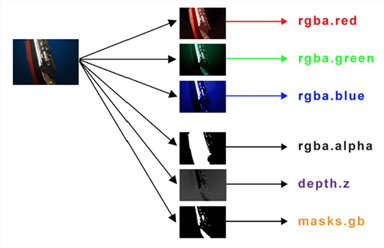Understanding Channels and Layers
At a very basic level, channels in Nuke carry image data and layers are containers for these channels, up to the maximum of 1023 channels per script. When elements are rendered out in the OpenEXR format, for example, you can operate on multiple channels from a single image.
|
|
| The layer name, in this case rgba, depth, or masks, followed by the channel name. |
Channels
Think of a channel as a container that contains image data. Once created or read into your composite, the image data stored in a channel is available downstream in the network until the value is replaced with something else or the channel is removed. The channel may even be “empty” - depending on where you reference it in the compositing network.
Layers
All channels in a script must exist as part of a layer (also called a channel set). You’re probably familiar with the default layer - rgba - which includes the channels with pixel values of red, green, and blue, and also the alpha channel for transparency.
All channels in a composite must belong to at least one layer. Some channels, like alpha, may be available in other layers, too. Channel names always include the layer name as a prefix, like this:
layer_name.channel_name.
By default, every script has a layer called rgba. When you first import an image element, Nuke automatically assigns its channels to the rgba layer - that is, the image channels are named rgba.red, rgba.blue, rgba.green, and rgba.alpha.
The rgba layer allows for the standard four-channel workflow of most node-based compositing systems. However, you’re not limited to these four channels. You can create new channels and assign them to new layers up to the limit of 1023 channels per script.

